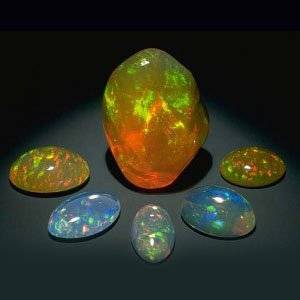Opal Facts and Myths

Myth: Opals have to be immersed in water periodically to avoid cracks.
Fact: Australian opal is extremely non-porous, and therefore soaks up no water, oil or any other kind of liquid. The water content that is present within in an opal, is the same as that which was present while the stone was being formed. This means that soaking your opal in water will do nothing to increase its longevity. That being said, it is not advisable to soak a cracked opal as water may enter the crack and jeopardize its structural integrity.
Myth: Opals are very fragile stones and prone to breaking
Fact: Opals are generally said to be as hard as glass. While they are one of the more delicate gemstones, opals are not as fragile as many think. It is advisable not to perform tasks that involve heavy lifting or vigorous activity when wearing these stones.
Myth: Opals need to be rubbed with baby oil, olive oil or glycerin to prevent cracking.
Fact: Australian opals are completely non-porous and will not be affected by any kind of liquid including baby oil, olive oil or glycerin.
Myth: Opals are prone to cracking
Fact: Most opals are very stable and do not crack easily. Any material that increases the likelihood of the stone cracking is removed during the mining, processing and cutting process.
Myth: Black opals are jet black
Fact: A black opal exhibits a range of colors, and its value is determined by its 'play of color'. The term black opal is used to identify stones with very dark body tones. The finest black opals may be more valuable than diamonds.
Myth: Strong light will cause an opal to die
Fact: Strong light does not affect the life of an opal. In fact, an opal will shine better under improved lighting.
Myth: Opal stones at high altitudes are more prone to cracking
Fact: High altitudes will not affect your opal. Only impact, extreme heat and high pressure may increase the possibility of your stone cracking.
Myth: Opals are bad luck
Fact: While some negative superstition continues to remain, opals have been considered and continue to be considered stones of good luck.
Myth: Triplets are opals of three different colours
Fact: The name 'triplet' refers to the layers present within a stone, not the number of types of opal. Triplets consist of a black backing layer, a clear layer and a thin slice of opal sandwiched in between.
Myth: The light that an opal emits comes from within the stone.
Fact: The vibrancy of color in light that opal stones display is due to phenomena known as reflection and diffraction of light. Light needs to bounce off the tiny silica spheres that make up an opal stone for the 'rainbow' effect to be created.
Myth: Warming an opal increases its brightness.
Fact: Slight heating your opal will do nothing to improve its brightness or 'play of colour'
Myth: Exposing your opal to a lightning storm will improve its color.
Fact: This myth is borne out of a number of non-scientific beliefs originating from Arabia. Lightning does not affect an opal stone in any way.


